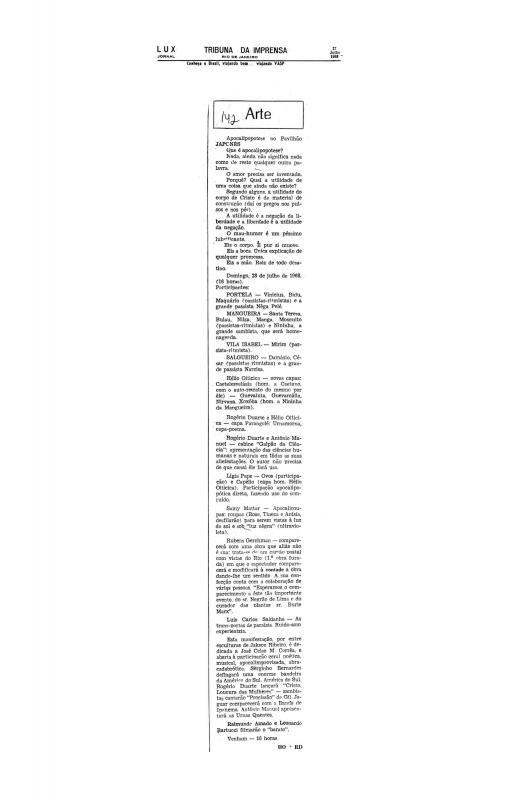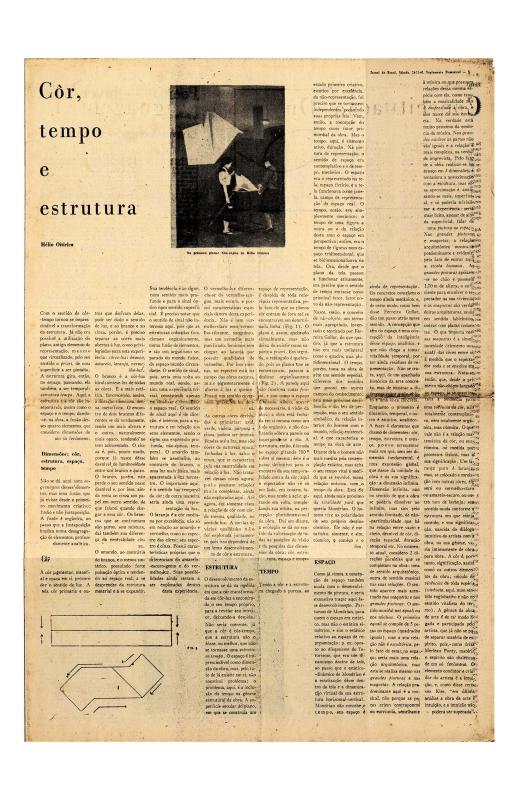Insofar as this text discusses the problem of criticism in an array of disciplines (film, music, and the visual arts), it reflects the multidisciplinary nature of the “Tropicália” movement that emerged in Brazilian art in the second half of the sixties. The central problem in Brazil, at least in the sixties, was the need to reformulate the discursive models at stake in all strains of criticism.
Journalist, producer, and music critic Nelson Motta was an essential player in Brazilian culture as well as an important opinion maker.
Hélio Oiticica (1937–80) was a Brazilian neo-concrete artist. After studying painting with Ivan Serpa at the Museu de Arte Moderna do Rio de Janeiro in 1954, he joined the Grupo Frente and the neo-concrete movement. In addition to the geometric paintings he worked on while studying with Serpa and as a member of Frente, Oiticica did performances and made participatory works. His Parangolés (1964)—capes made with fabric and recycled materials—were used for performances at the Mangueira Samba School. Oiticica also created enveloping spaces like his Nucleus (1959–60), an environment constructed with hanging and painted strips of wood based on Piet Mondrian’s constructivist ideas. In 1967, he made the environment Tropicália at MAM-Rio. Tropicália was an installation of rooms with plants and materials (water, sand, and stones, as well as a parrot, a television set, and other elements from Brazilian popular culture), that is, an environment designed to stimulate the senses. He applied the same principles in the work Eden, an environment created in 1969 at the Whitechapel Gallery in London. The name Tropicália was later used by Brazilian musicians to refer to a new style of music that brought together international pop and traditional Brazilian music. The word, which came to form part of Brazilian popular culture, is applied to something Brazilian in nature. In 1970, Oiticica took part in the group show Information held at the Museum of Modern Art in New York.
[For further reading, see in the ICAA digital archive the following texts by Oiticica: “Aparecimento do suprasensorial na arte brasileira” (doc. no. 1110620), “Apocalipopótese” (doc. no. 1110682), (untitled) [“Apocalipopótese no Pavilhão Japonês (…)”] (doc. no. 1110621), “Brasil diarréia” (doc. no. 1090409), (untitled) [“Cada vez que procuro situar (…)”] (doc. no. 1110352), “Côr, tempo e estrutura” (doc. no. 1110353), “Declaração de princípios básicos da vanguarda” (doc. no. 1110371), “Esquema geral da nova objetividade” (doc. no. 1110372), “Helio Oiticica: lettre ouverte aux sélectionnés” (doc. no. 774506), “O objeto: instâncias do problema do objeto” (doc. no. 1110629), “A obra aberta” (doc. no. 1110619), “Parangolé: da anti-arte as apropriações ambientais de Oiticica” (doc. no. 1110631), “Situação da vanguarda no Brasil” (doc. no. 1110376), “Sobre o ‘Projeto Cães de Caça’” (doc. no. 1110354), (untitled) [“Text from Information, MoMA (1970) (…)”] (doc. no. 1126341), “Tropicália” (doc. no. 1074985), and “A transição da côr do quadro para o espaço e o sentido de construtividade” (doc. no. 1110351)].
















